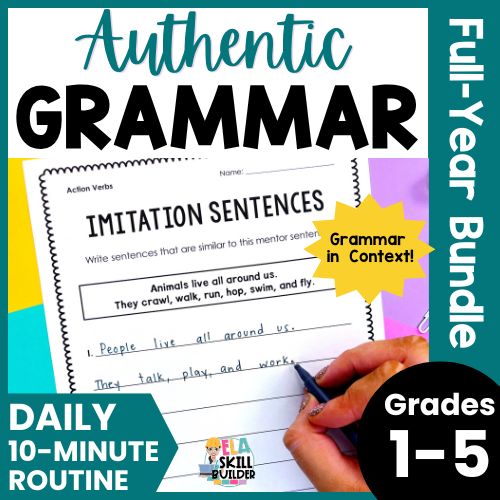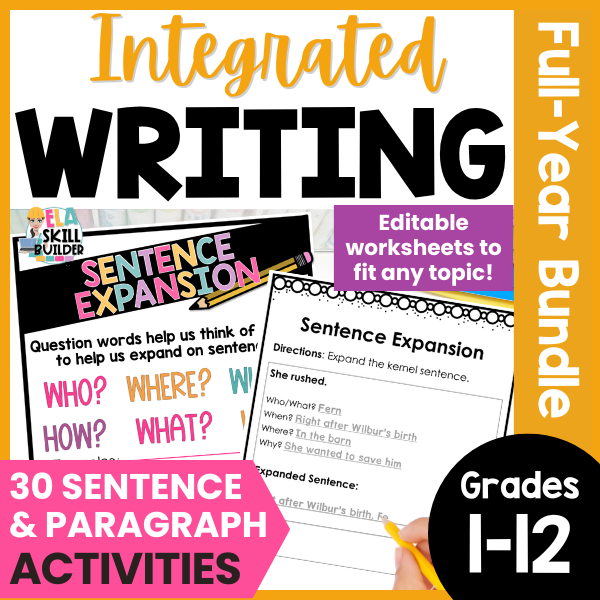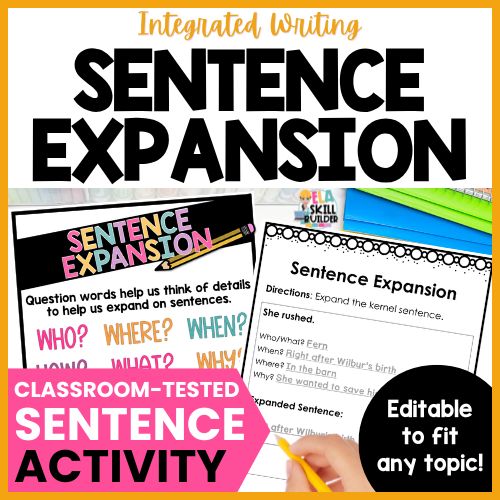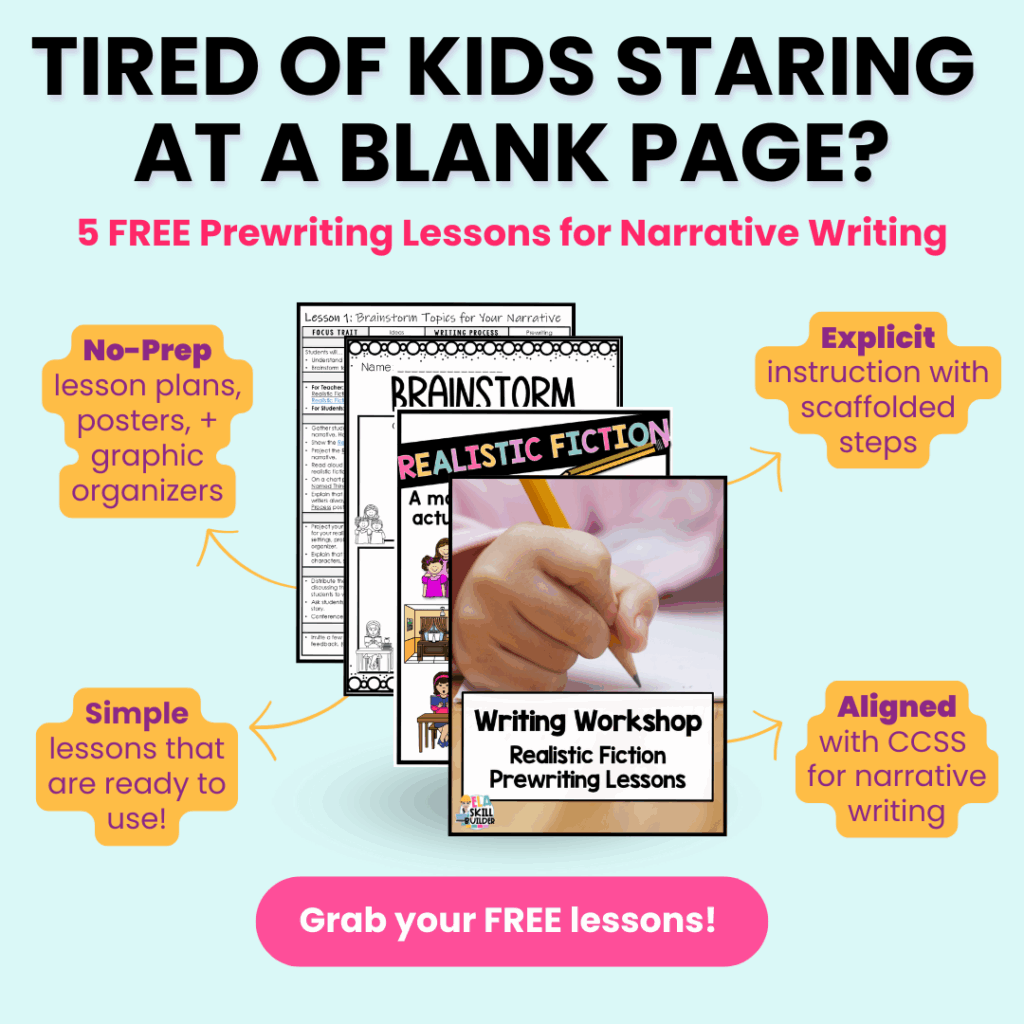

The 5 Biggest Mistakes I Used to Make When Teaching Grammar – Do You Make Them Too?
I used to spend about 30 minutes a day teaching grammar in my classroom. We did all the things – worksheets, grammar stations, correcting sentences, you name it. But no matter how much time I spent, I wasn’t seeing the results I hoped for in my students’ writing. Their sentences were still choppy. Their grammar errors kept showing up. And I remember thinking, What am I missing?
It wasn’t until I started helping my husband with research for his grad school project on best practices for grammar instruction that things finally clicked. As I dove into the research, I realized – I’d been making some BIG mistakes in how I was teaching grammar. And to be honest, I don’t think I’m the only one.
If you’ve ever felt frustrated that your grammar lessons don’t seem to transfer into your students’ actual writing, this post is for you. Let’s walk through 5 of the biggest mistakes teachers (including me!) often make when teaching grammar – and what to do instead.
Mistake #1: I spent almost my entire writing block just teaching grammar.
At first glance, it might sound admirable that I devoted a solid 30 minutes a day to grammar instruction. I mean, who doesn’t want their students to master parts of speech and punctuation, right?
But here’s the truth: I was using most of my writing block on grammar mini-lessons and worksheets… which left hardly any time for actual writing. To be honest, I didn’t even mind it at the time – writing felt so hard to teach, and grammar felt more structured. So I filled the block with what felt easier. Guilty!
What I Learned: Grammar Should Support Writing, Not Replace It
Over time, I realized what a disservice I was doing to my students. They weren’t getting enough time to write, revise, or apply what they were learning. That’s when I started learning about the writing workshop model and slowly restructured my entire block.
Now, grammar gets just 10 focused minutes at the start of the block. Then, we move into writing time – where students are expected to apply the grammar skill in their own writing. That’s where the real growth happens.
Here’s a sample schedule showing how I now fit both grammar and writing into my day in a way that supports all writing standards and gives students the time they need to become confident, capable writers.
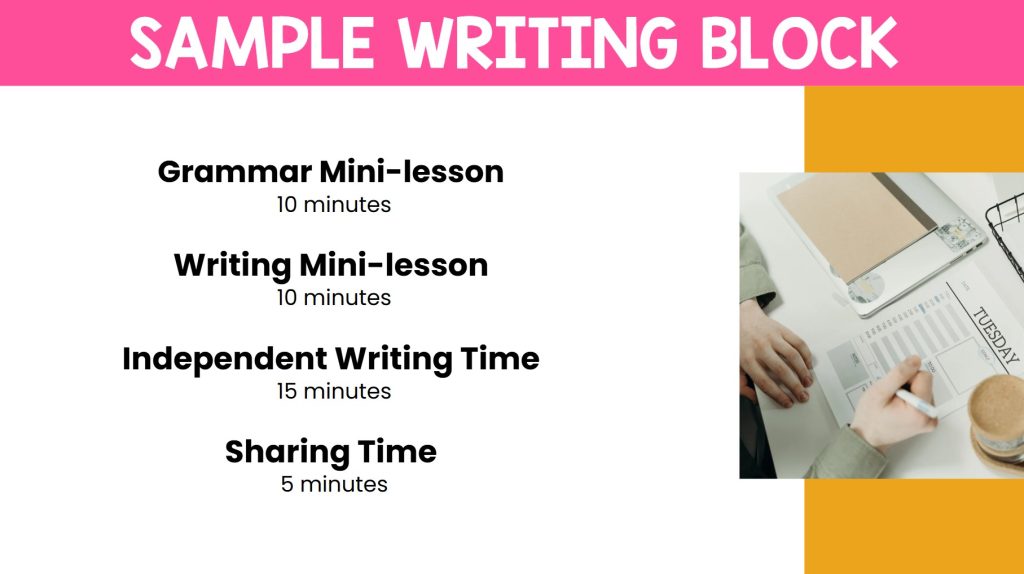
Mistake #2: I thought my students had to master grammar rules before they could apply them.
For the longest time, I believed this. I thought if I could just get my students to memorize the rules, what a preposition was, how to use commas, when to capitalize, they would naturally start applying them in their writing. So I would spend lots of time on the smart board going over grammar rules and doing multiple examples. Then, I would give them worksheets to practice identifying parts of speech or correcting punctuation, making sure they really understood the rules.
But even with all that practice, those skills rarely showed up in their actual writing unless I specifically reminded or prompted them. They might do well on the worksheets, but when it came to applying the skills independently in their own stories or essays, it just did not stick.
I realized that simply memorizing rules and doing isolated practice was not enough. Grammar needed to be taught in context—embedded in real writing—so students could see how it actually works to make their writing clearer and stronger.
What I Learned: Students need to see grammar in real writing first.
It wasn’t until I started learning more about best practices that I realized how backwards my approach was. Research shows that students learn grammar more effectively when they see it used in context, in actual writing. That’s where mentor sentences come in, and once I started using them, everything changed.
Now, I introduce one grammar skill per week using a short, well-crafted mentor sentence. Instead of hitting them with a list of rules, I guide students to notice how one specific grammar skill is used to enhance meaning or clarity in the sentence.
For example, when introducing proper nouns, I might use this mentor sentence:
“Mr. Tanen is the principal of the Lynnhurst Elementary School.”
We would zero in on the proper nouns, “Mr. Tanen” and “Lynnhurst Elementary School.” Students explore how these specific names give the sentence clarity and meaning. They are not just memorizing rules about proper nouns – they are discovering them through inquiry.
This approach is so much more engaging and effective. Students feel like real writers analyzing real writing. Because they understand the purpose of the skill, they are much more likely to use it in their own work.
Letting students explore and uncover grammar on their own, with a clear weekly focus, makes the skill stick. It is simple, meaningful, and a lot less dry than traditional grammar drills.
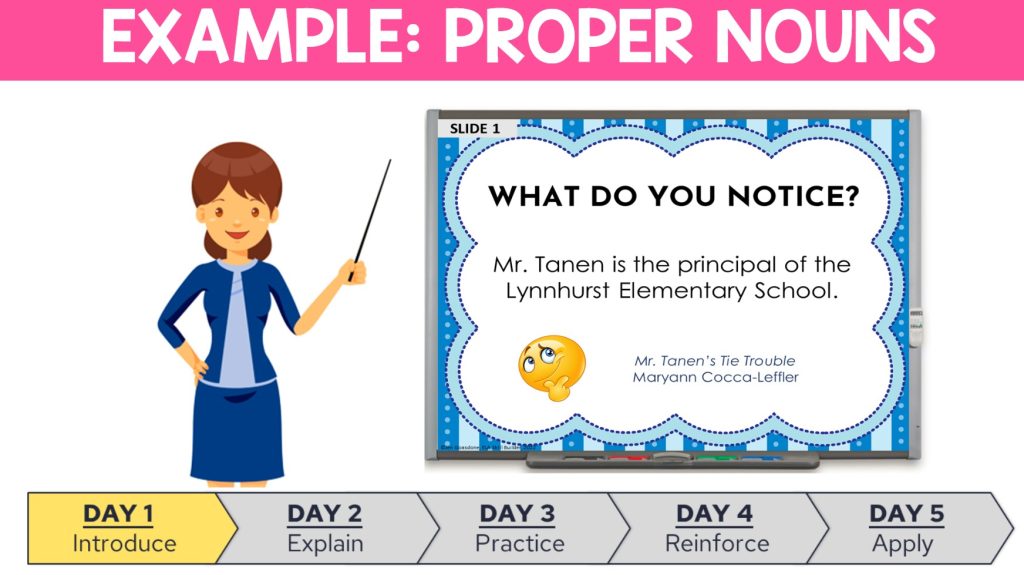
Mistake #3: I Mostly Used Grammar Practice That Focused on Correcting Errors
For years, my grammar instruction revolved mostly around worksheets where students had to fix mistakes in poorly written sentences. It felt like a practical way to help them “see what’s wrong.” But as I started digging into research, I learned that error correction isn’t actually an effective way to teach grammar. In fact, it can be confusing and even counterproductive—especially for younger writers.
What I Learned: Students Need to Practice Using Grammar Correctly, Not Just Spotting Mistakes
Research has found that focusing on error correction can unintentionally reinforce mistakes in student writing. When students spend too much time identifying and fixing errors, they often get stuck noticing what is wrong instead of learning how grammar adds clarity and meaning to their writing. That is not the outcome we want.
Instead, the best way to teach grammar is by showing quality examples of how real authors use grammar to enhance their writing – think mentor sentences. When students see grammar in action within strong writing, they understand its purpose.
Then, having students apply those grammar skills by writing their own sentences helps them make the connection between the skill and meaningful writing. Activities like imitation sentences give students a clear, guided way to practice grammar in context, which builds stronger habits than error correction ever could.
For example, if the mentor sentence is:
“Mr. Tanen is the principal of the Lynnhurst Elementary School,”
you might guide the class in writing an imitation sentence like:
“Mr. Brown is my teacher at Bear Creek School.”
After modeling it together, students can pair up or write independently to create their own imitation sentences using proper nouns. This helps them internalize the grammar skill and see how proper nouns add clarity and specificity to their writing – without getting stuck trying to correct someone else’s mistakes.
By shifting away from error-focused worksheets and toward meaningful practice with mentor texts and imitation sentences, we set students up to write with more confidence and purpose.
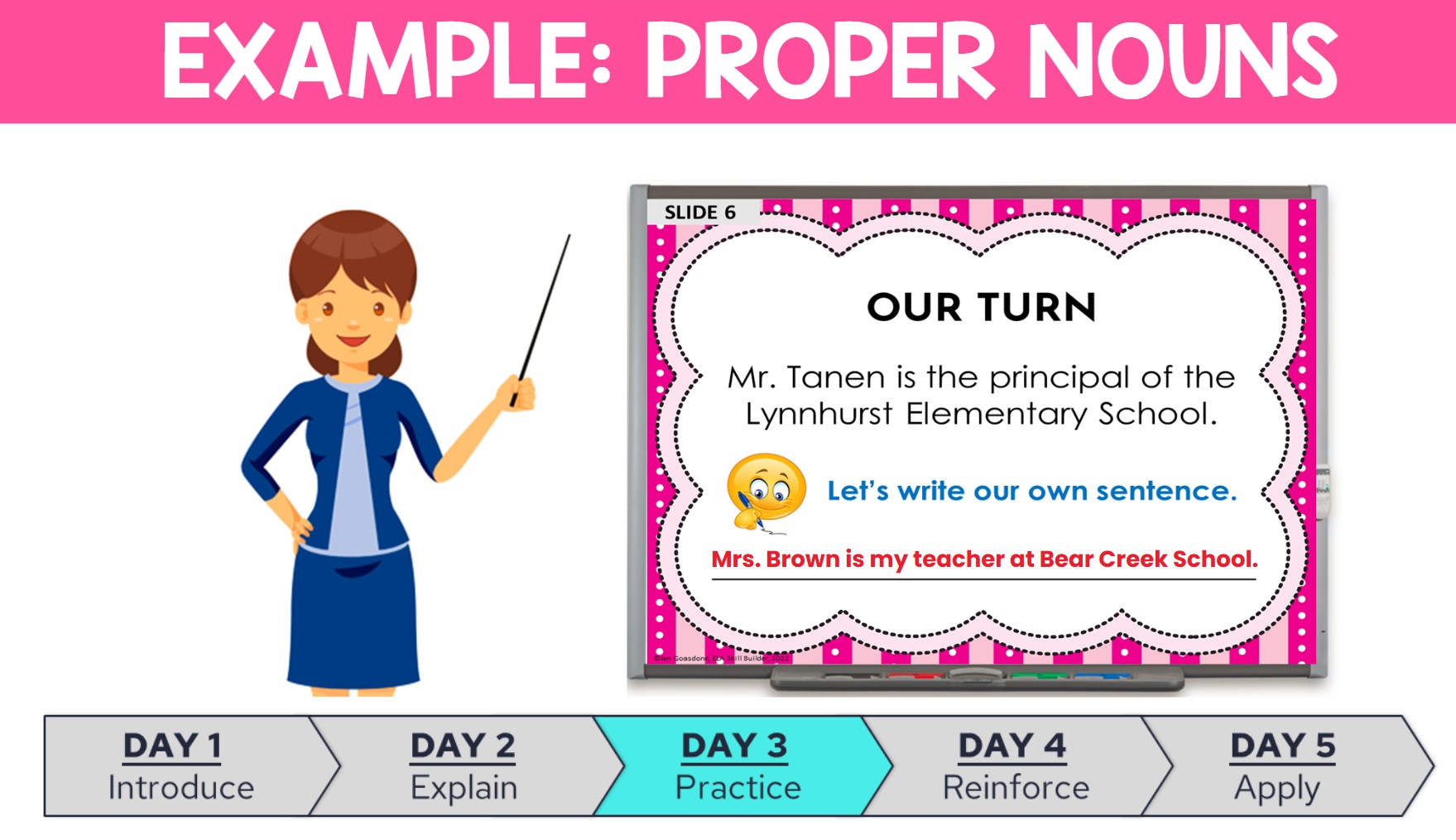
Mistake #4: Expecting Students to Revise Their Writing for Grammar Without Proper Guidance
I used to think that once I taught a grammar skill, students could just go back to their writing and fix it on their own. I assumed that teaching the rule was enough and that students would naturally catch and correct their mistakes during the revision stage of the writing process.
But revision is actually a complex skill that takes a lot of practice and support. Without clear modeling and scaffolding, students often don’t know what to look for or how to improve their writing in specific ways. They might skim over their work and miss important grammar details entirely.
What I Learned: Model Revision Step-by-Step Using Targeted Checklists
What really helped was introducing a focused approach to revising for grammar. I started using a checklist that addressed only the targeted grammar skill we had been working on. Before asking students to revise their own writing, I would model the revision process using a sample piece of writing.
We would look together for the specific grammar skill, talk through what needs to be changed or improved, and make edits as a class. This step-by-step demonstration showed students exactly what to look for and how to make their writing stronger.
Once they saw the process in action, students felt more confident revising their own writing for that specific grammar skill. This kind of scaffolding makes a huge difference. It breaks revision down into manageable steps and helps students develop the skills to self-edit effectively over time.
If we want students to truly apply the grammar skills we teach during revision, we need to guide them through it—not just expect them to do it on their own.
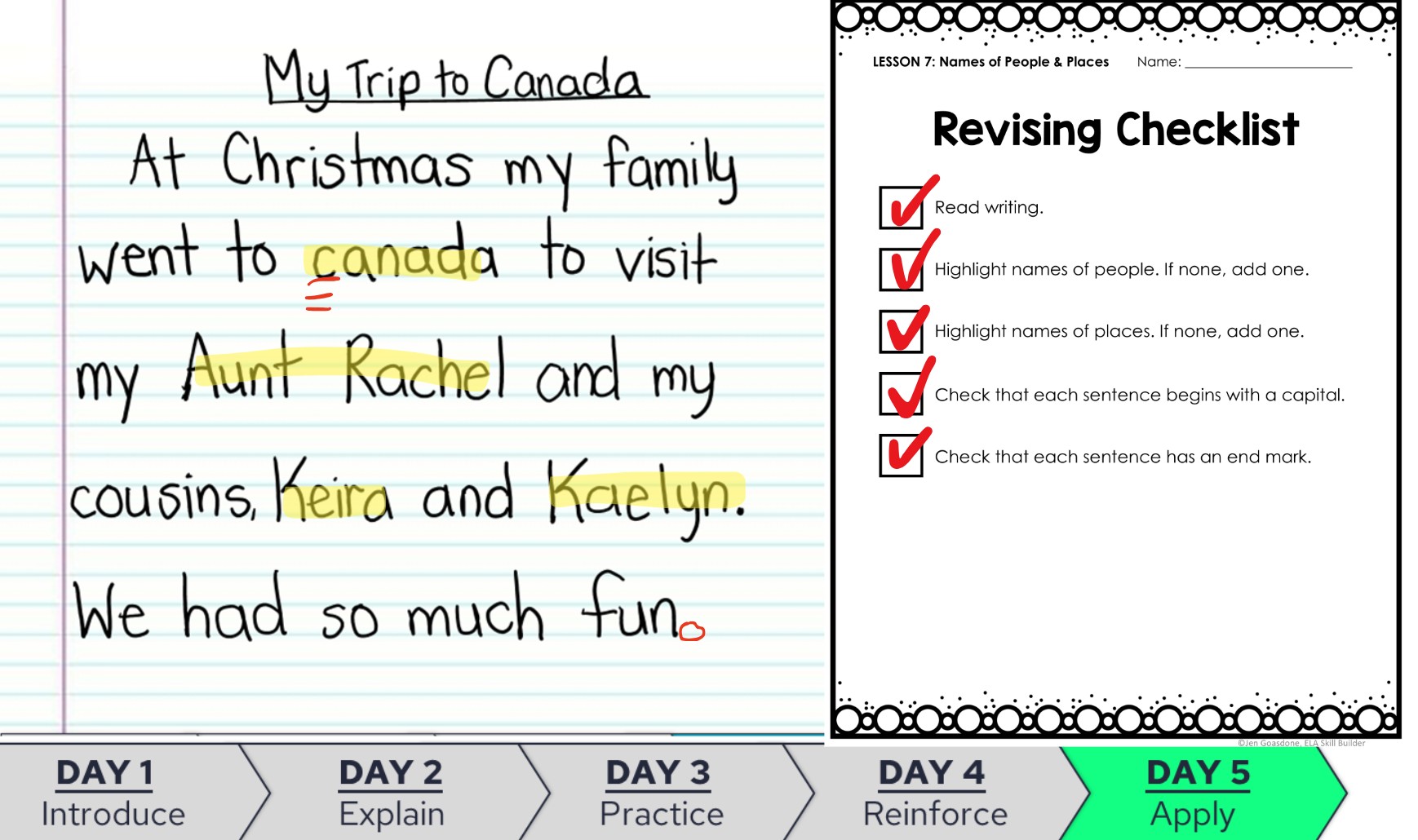
Mistake #5: Using Poor Assessments to Teach Grammar
At first, my go-to grammar assessments were worksheets where students had to identify parts of speech or correct errors in isolated sentences. While these seemed helpful, I wasn’t really checking if my students could apply the grammar skills in their own writing — which, let’s be honest, should be our real goal.
What I Learned: Use Authentic Assessments That Focus on Application
The shift came when I started using authentic grammar assessments. Instead of testing grammar in isolation, I gave students a writing prompt and asked them to respond using the targeted grammar skill we’d been working on.
For example, if the skill was using proper nouns, I might prompt students to write three sentences, encouraging them to include specific names of people and places to add clarity and detail.
This way, I could see not just if they recognized the skill, but if they could actually use it to improve their writing. Authentic assessments like these give a clearer picture of students’ understanding and help guide next steps in instruction.
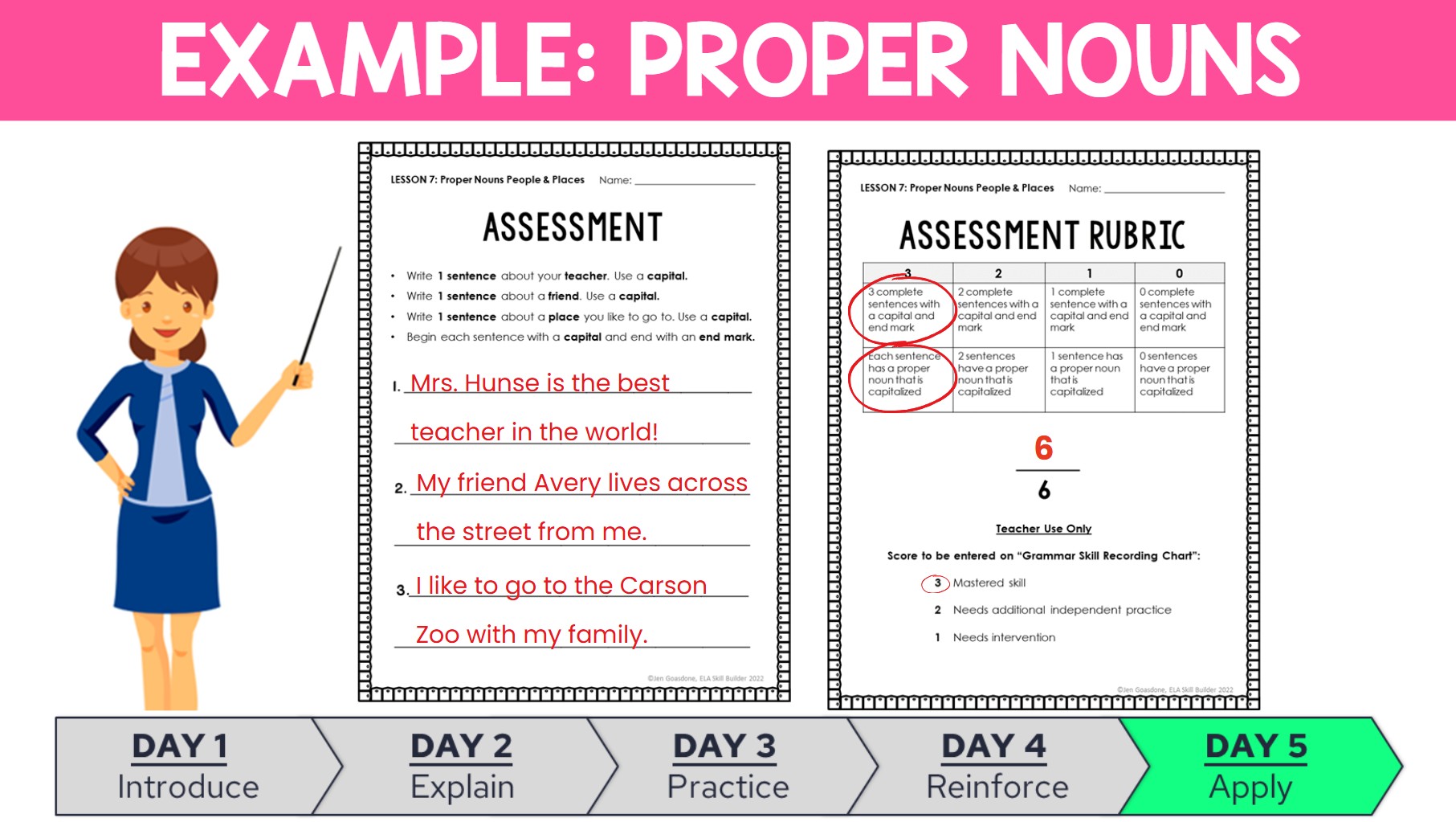
Try This: 5-Day Grammar Routine
Interested in a classroom-tested weekly grammar routine that gets your students using grammar skills in their writing? This free download includes a 5-day lesson plan template you can use with any grammar skill – and it only takes 10 minutes a day.
Click here to grab this free 5-day grammar routine!
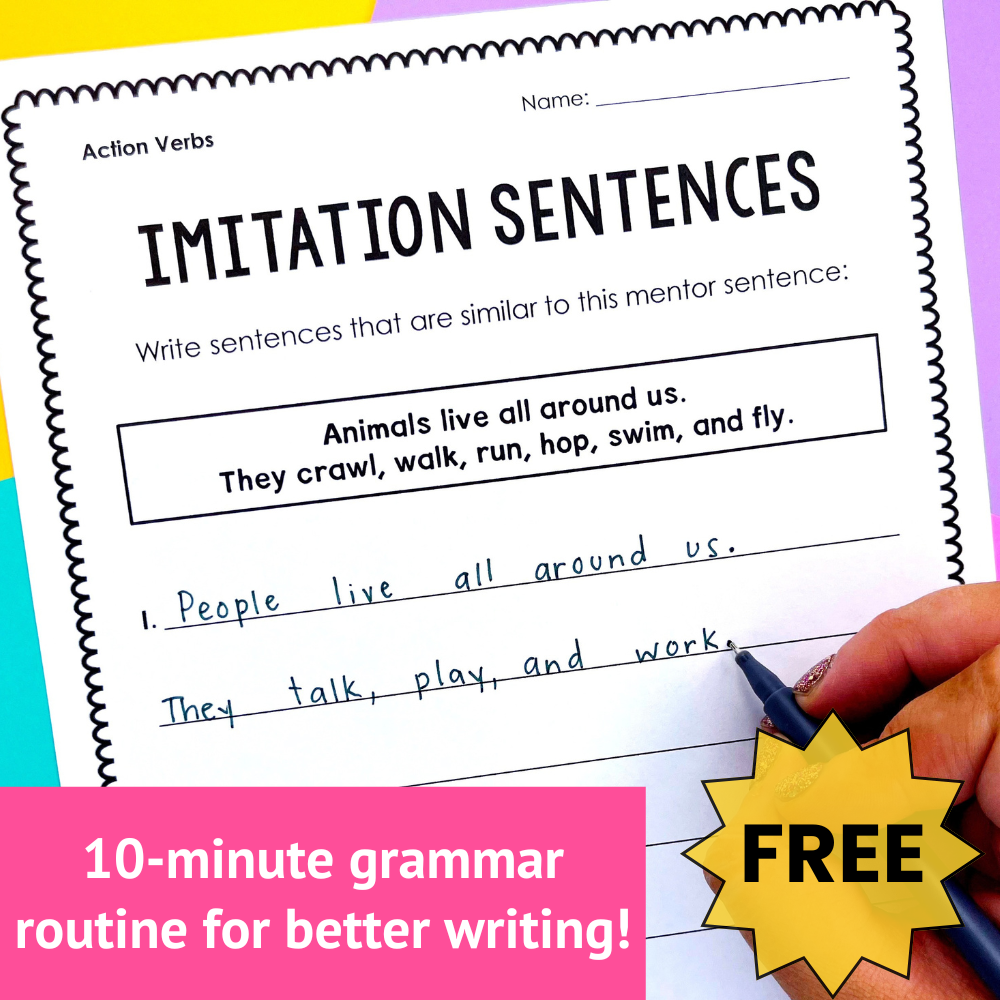
Conclusion
I’ve been there—making these mistakes, thinking I was doing what was best for my students. But I’ve learned that a lot of teachers are in the same boat, trying to teach grammar the “old way” because that’s what feels familiar or because they don’t have the right tools yet. The good news is, we don’t have to keep doing it this way.
With just a few simple shifts and the right resources—like a clear, easy-to-follow 5-day grammar routine—you can start teaching grammar in a way that actually sticks. When you focus on teaching grammar in context, using mentor sentences and meaningful writing activities, you’ll not only enjoy the process more, but you’ll also watch your students begin to transfer those skills naturally into their own writing.
No more isolated drills or endless worksheets. Instead, you’ll have confident writers who understand grammar because they’ve experienced it, explored it, and applied it regularly. If you’re ready to make that change, check out the 5-day grammar routine. It’s designed to fit easily into your day and help you feel great about your grammar instruction.
Here’s to teaching smarter, not harder – and to students who love writing because they get it.
About Jen Goasdone
Jen Goasdone, the owner of ELA Skill Builder, is a dedicated educator committed to empowering teachers with simple, research-based strategies for effective writing instruction. With a focus on making ELA teaching easier and more impactful, Jen helps students build a strong writing foundation that will serve them for years to come. Passionate about both teacher and student success, she strives to make writing instruction enjoyable and effective for elementary students.


Hey Teachers,
I'm Jen from
ELA Skill Builder!
My mission is to empower elementary teachers like you with the tools and confidence to teach writing effectively, so your students can grow into strong, capable writers.
Best Sellers!
Writing resources
Features explicit writing workshop lessons for narrative, informational, and opinion writing.
Grammar resources
Features a simple weekly routine that teaches grammar in context in just 10 minutes a day.
writing prompts
Features 810 prompts designed to strengthen paragraph writing skills all year long!
cross-curricular writing
Features 30 sentence and paragraph activities inspired by The Writing Revolution that fit any subject.
coupon code
Get 15% off Your First Purchase
free lessons!
Grab 5 free prewriting lessons to kick off your narrative writing unit – all materials included!
jOIN A COMMUNITY
writing training
Features 4 hours of video lessons designed to help you run a structured, effective, and engaging writing block.
free gramamr routine!
Features a free 5-day routine for teaching any grammar skill in context, in just 10 minutes a day!
free SENTENCE ACTIVITY
Features a free, editable sentence activity that helps students expand sentences for any topic.
contact jen!
Got questions? Fill out this contact form, and I’ll get back to you as soon as possible.




